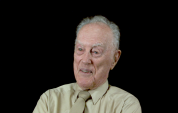5:16 | He was already married with a child, but Richard Lewis enlisted because America was having a tough time of it in the early war. He passed the tests to go to flight school and progressed through them until he was a B-24 pilot heading to England. He flew both B-24's and B-17's for a total of 35 missions.
Keywords : Richard Lewis Arkansas City KS pilot flight school Consolidated B-24 Liberator Boeing B-17 Flying Fortress

Flying was always a thrill for Richard Lewis. He picked it up quickly and was the first of his group to solo. The trainer was very primitive, with no electronics and a hollow tube for communication. He became a heavy bomber pilot and was en route to England when D-Day happened.
Richard Lewis was flying the B-24 when he got to England, but after ten missions the squadron was moved into B-17's. That was fine with him, because he disliked the B-24 from the beginning and he tells you exactly why.
It was his tenth mission. As the bomb run began, B-24 pilot Richard Lewis lost an engine. It just quit, seemingly starved of fuel. As he tried to solve the problem, another engine went quiet. Now they were in trouble.
There was no evasive action on a bomb run. You had to come in straight and level and stay in formation for the sake of the targeting. At least you didn't usually have to worry about the flak in transit because it was concentrated around the target. Richard Lewis remembers once, though, when the they heard the boom, boom over a forest.
At the end of his last bombing mission, Richard Lewis buzzed the tower. What could they do? He was going home. They made an instructor out of him for a while, but he had enough points for discharge, so he was out before VJ Day. He stayed in the reserve so he could still fly Uncle Sam's planes.
Heavy bomber pilot Richard Lewis was taking his crew on a check flight in their new plane, a B-17. The radio operator was a former aviation cadet and asked if he could try it for a while. What could go wrong?
Although activated during the Korean War, heavy bomber pilot Richard Lewis was never sent there, instead serving in Tucson with a B-50 unit. That unit had some hush, hush operations, including a plane armed with an atomic bomb aloft 24/7.
Pilot Richard Lewis decided not to stay active, but he stayed in the Reserve with a unit at a small airfield. He was pushed out of that when he got a promotion and he eventually wound up with a position that he liked very much, so much that he stayed in until he reached thirty years service.